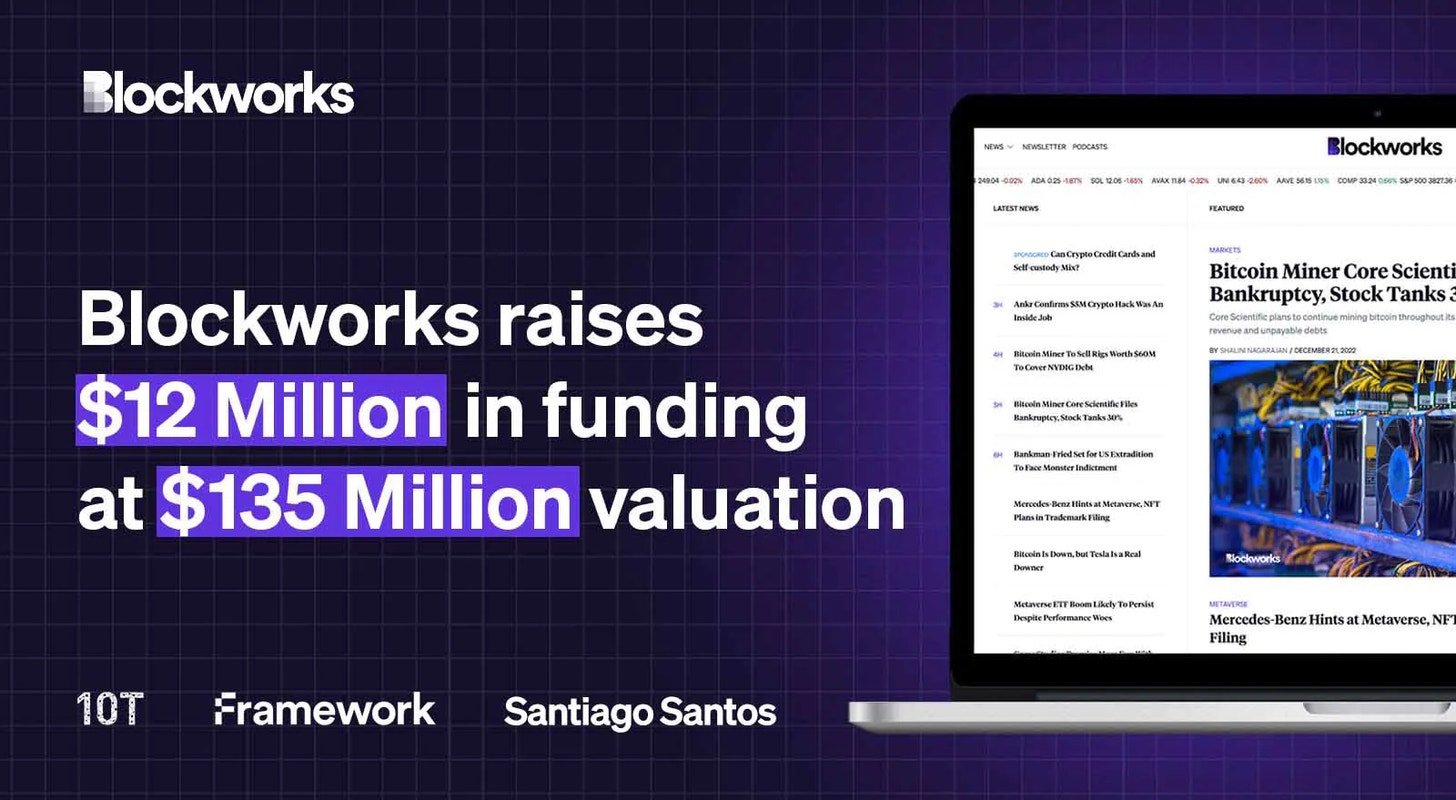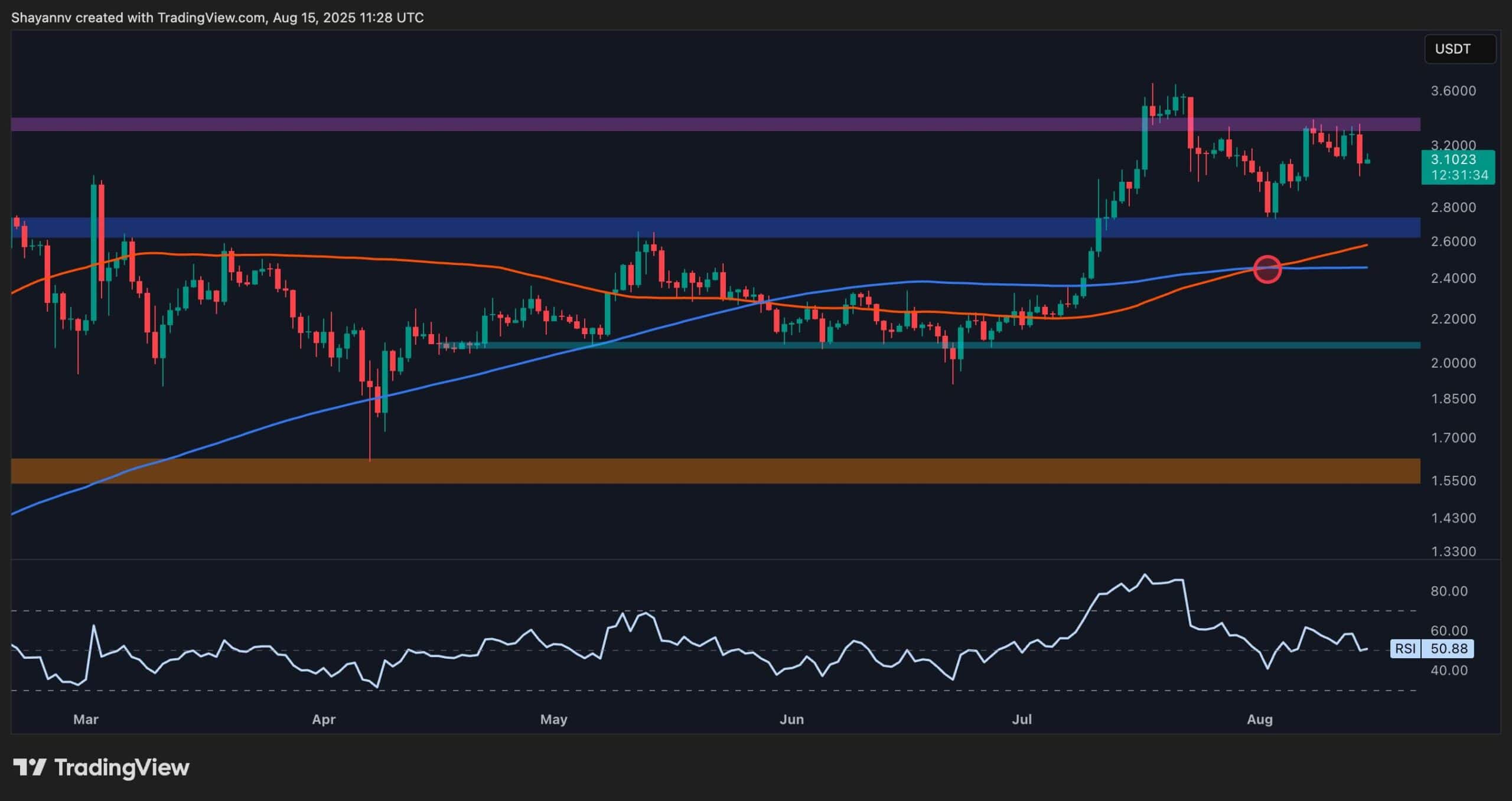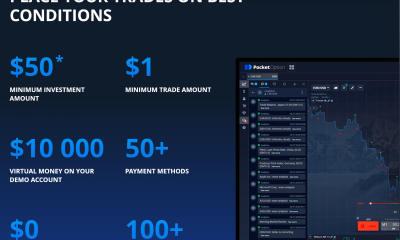Cryptocurrency
Blockworks’ Jason Yanowitz On Building ‘The Largest Research And Analytics Platform’ In Crypto

Last month, Blockworks announced a $12 million fundraise, putting its valuation at $135 million. Coverage of the event said the brand would use new funds to expand globally and build a research and data offering.Benzinga caught up with co-founder Jason Yanowitz to discuss the event in detail, as well as what he sees for the future of crypto.The following conversation was edited for brevity and clarity.Q: Hello Jason, it is nice to meet you. Care to start with an introduction, mentioning some of the early motivations for embarking on the Blockworks journey?Jason Yanowitz: While visiting Hungary in 2015, I heard about Bitcoin BTC/USD. Having learned about how people grew up in the region during the 1950s and ‘60s, the idea of self-sovereign money and breaking free from tyranny was enticing.In 2017, I was introduced to Ethereum ETH/USD and realized there were only a few good sources of information. Information asymmetries shaped the original thesis for the Blockworks business.Talk about Blockworks’ inception. How did you build this business, and how was it different from how other businesses in the space are built?When building media businesses, you start with the content. After you have an audience, you monetize through products such as newsletters and events.We built our media company backward. We started with conferences first. We hosted happy hours that brought together the institutional and crypto crowds.This eventually led to the creation of our very popular Digital Asset Summit, probably the only crypto event where people are still wearing suits and ties.Then, we added a podcast network, our first step into what I would call digital media.When the pandemic happened, we realized we needed to double down on the media side of the business to fill in some holes. We added reporters from Bloomberg, CNBC and the Wall Street Journal to help us create a world-class media company, launching a new media site in 2021.Talk about how the fundraising conversation looked like.2021 was a parabolic year for us. The newsletter business grew exponentially, and we added several podcasts, which are doing tens of millions of downloads, as well as a webinar business and conference in partnership with Bankless. It’s called Permissionless, a decentralized finance (DeFi) crypto-native event attended by the thousands.At the end of 2021, we started talking to our audience again, asking them what they needed. We learned they needed a professional platform through which they could get governance, protocol data, and information, as well as insights into on-chain activity. For instance, finding and comparing the user metrics of a Uniswap UNI/USD and Sushiswap SUSHI/USD, or finding what the revenue of an Aave AAVE/USD is compared to Compound COMP/USD.We hired a CTO, built an engineering and product team, and spent time building until we launched in May 2022. Within a year, we will have the largest research and analytics platform in all of crypto.What’s this current bear market doing for your business?If you look at traditional SaaS businesses, they usually raise a bunch of money, and most of this money goes to marketing and customer acquisition while the other half goes to product and engineering.For us, we have a profitable business, so we already spin off a lot of cash flow that gets reinvested in the product, and then we don’t have to spend any money on marketing because we have millions of people who read our media site.We drive those people down the funnel. We see this bear market as an opportunity to put some fuel behind the fire and accelerate growth, leapfrogging our competitors.Can you talk more about the details of the fundraising?We raised $12 million in funding at a $135 million valuation. 10T Holdings led the investment, Framework Ventures and Santiago Santos participated.People don’t realize there are many different types of VCs. The challenge for us was picking the right ones.Reasons we asked 10T to lead this round include the narrative they conveyed around profitability.The downfall over the last decade of technology investing comes from VCs who pushed their portfolio of companies to get on the VC hamster wheel. We wanted to keep building a profitable media and information business. We were looking to accelerate the growth while keeping the culture intact.Do you want to talk about your intentions to expand globally? What’s driving that?There’s never been more interest in Asia. Much of this interest is the result of regulatory regimes elsewhere. For example, look at how the regulators in the U.S. are treating brands like Coinbase Global Inc. It’s pushing a lot of the best entrepreneurs and investors overseas.China had a strict ban, but they’ve done a complete 180 largely because they see the potential capital flows. So, Singapore, South Korea, and Hong Kong are our target areas where we’re actively looking to host some conferences.Who has all the capital?The U.S. has the capital. When you look at things like DeFi and trading, we’re still the most dominant. What we don’t have are the users, and that’s due to regulators making it very tough for them to use things like VPNs.London and the EU have taken a different, methodical approach. They just put in place a regulatory framework called MiCA, and that’s driving a lot of entrepreneurs there because they have a better idea of what the constraints are.Can you talk a little bit about Blockworks’ mission and operational alignment?Our mission is to drive forward the most important conversations in the industry. I don’t think talking about the price of a token is the most important conversation. Even if we have to sacrifice page views or attendance at a conference, we will always stand true to this view.Good content will win out in the long term. We’re playing a very long-term game.There are two ways to scale a crypto media company. You can go the angle of growing page view numbers. On the other hand, we go a completely other direction, which is very deep and niche.For example, we have one podcast called Bell Curve. We just finished a whole season on this thing called MEV or Maximal Extractable Value. There are probably less than 5,000 people in the world who care about MEV, but when MEV becomes a hot topic in the future, we’ll be seen as the definitive knowledge source.We don’t want 100 million people to read Blockworks. We want a million of the most powerful crypto executives and investors in the world to read us. Right now, those are the people that care about MEV.Notwithstanding the crypto winter narrative, what keeps you so optimistic and bullish, and what are some of the ways you’re playing this view beyond what we talked about?We launched Blockworks in December 2017. That was the top of the market, and we’ve basically been building for two and a half years straight into a bear market, now.We like bear markets a lot. It’s easier to think, breathe and build substantial products. Crypto will do the same thing for finance the Internet did for information; the Internet made it incredibly easy for information to flow in near real-time. It unlocked a ridiculous amount of capital and human talent, and there was no way to predict this would happen.Finance is very walled and grows slowly. If you want to send money to a friend in London, it may take days for it to get there. It is a very archaic system, and we believe there is a lot of good that will come to the world if you break the walled gardens of finance.What’s one tip you may have for people trying to grow their own startup?Running out of money kills companies. We got this advice a month two into the business from another founder. We were in a room and thinking through what products we should build. We had two people, and Coindesk had 150. We kept thinking about how we could do things better. This other founder looked at us. After building companies for 30 years, they said the best way was to survive the longest.If you look at a lot of other crypto media companies, they played some dirty tricks to grow fast. They won’t survive. I think you don’t need the best product across the board. Instead, you need to be slightly more cautious than people think they need to be.Odd question. Have you encountered imposter syndrome?We did. Nobody thought crypto would work back in 2018 or so. It was a dead industry. There’s a funny site showing how many times the media mentioned Bitcoin is dead. In 2019, it was like 300 times. My old company called me, offering me a job if I wanted it at the time.As a founder, it probably isn’t a healthy thing, but my identity is so tied up in the company’s success that it pushes me to keep going. We had to succeed because we had tied everything up, including our reputation, in the business. Founders can’t have alternative plans. Failure isn’t an option.Any parting words?I’m excited about our research and data platform. I am spending a lot of time there, and I think the exciting thing happening in digital media is the death of major brands that used venture money to buy trust. I think it was essential for us to bootstrap the business so that we didn’t try to use venture money to buy trust.If you look at the most successful media companies in the world, they all have a product at the bottom of the funnel. Bloomberg has the Terminal and Politico has Pro. You even have The Hustle, a newsletter acquired by Hubspot Inc HUBS. They wanted to put their products at the bottom of that media funnel. Infatuation got acquired by JPMorgan Chase & Co JPM to drive users to their Sapphire Preferred. Barstool Sports got bought by PENN Entertainment Inc PENN and put a casino at the bottom of the funnel. That’s the future of media, and we’re excited about that.A decade from now, what do you see?Crypto will be the underlying technology of the entire financial market. Crypto as an asset class will be one of the largest in the entire world, and that will translate to Blockworks competing with brands like the Wall Street Journal.Photo: Courtesy Blockworks
Cryptocurrency
Ethereum Foundation, Whales, and Hackers: What’s Driving the ETH Sell-Off?

TL;DR
- Whales, hackers, and the Ethereum Foundation wallets moved over $500M in ETH through large sales and withdrawals.
- Ethereum transfers rose to 4.6M ETH, nearing the monthly high of 5.2M recorded in July.
- Staking inflows hit 247,900 ETH, the highest in a month, locking more supply from trading.
Large Withdrawals and Whale Activity
Ethereum (ETH) has seen heavy movement from major wallets over the past few days. On-chain data from Lookonchain shows a newly created wallet pulled 17,591 ETH, worth $81.62 million, from Kraken in just two hours.
Over three days, two new wallets withdrew a combined 71,025 ETH, valued at $330 million, from the exchange.
One of these wallets, address 0x2A92, has withdrawn 53,434 ETH, worth $242.34 million, in two days. This includes a recent purchase of 30,069 ETH, valued at $138.46 million, during a market drop.
Major ETH Holders Offload Millions Amid Price Rally
In contrast, several separate entities have been disposing of some ETH holdings. A wallet tied to a hacker address 0x17E0 sold 4,958 ETH for $22.13 million at $4,463, securing a profit of $9.75 million. Earlier this year, the same address sold 12,282 ETH at $1,932 and later bought back part of the amount at higher prices.
A different whale sold 20,600 ETH for $96.55 million over the past two days, generating a profit of more than $26 million after holding the position for nine months.
Meanwhile, an Ethereum Foundation-linked wallet, 0xF39d, sold 6,194 ETH worth $28.36 million in the last three days at an average price of $4,578.
Recent sales from the same wallet included an additional 1,100 ETH and 1,695 ETH for over $12.7 million combined.
The #EthereumFoundation-linked wallet(0xF39d) sold another 1,300 $ETH($5.87M) at $4,518 ~11 hours ago.
Over the past 3 days, this wallet has sold a total of 6,194 $ETH($28.36M) at an average price of $4,578.https://t.co/4hfCWymHVG pic.twitter.com/ErUyEY8SJy
— Lookonchain (@lookonchain) August 15, 2025
Network Activity on the Rise
CryptoQuant data shows Ethereum’s total tokens transferred have been climbing since August 9. After ranging between 1 million and 3 million ETH through late July and early August, transfers have risen to 4.6 million ETH, approaching the monthly high of 5.2 million recorded in mid-July. This increase has occurred alongside a price rally from about $3,400 to $4,600.
Interestingly, staking inflows generally stayed between 20,000 and 80,000 ETH per day over the past month. On August 14, inflows jumped to 247,900 ETH, the highest in the period.
At the time, ETH was trading near $4,600. Large staking deposits reduce the amount of ETH available for immediate trading, as staked coins are locked for a set period.
In the meantime, ETH trades at $4,647 with a 24-hour volume of $68.25 billion, down 2% on the day but up 19% over the week.
Binance Free $600 (CryptoPotato Exclusive): Use this link to register a new account and receive $600 exclusive welcome offer on Binance (full details).
LIMITED OFFER for CryptoPotato readers at Bybit: Use this link to register and open a $500 FREE position on any coin!
Cryptocurrency
Massive DOGE Whale Activity Hints at $1 Breakout

TL;DR
- Whales bought two billion DOGE this week, lifting their combined holdings to 27.6 billion coins.
- A single 900M DOGE transfer worth $208M to Binance drew attention to large exchange movements.
- DOGE broke key resistance, with momentum building for a possible push toward the $1 price mark.
Price and Market Moves
Dogecoin (DOGE) traded at $0.23 at press time, slipping 4% over the past day but still showing a 2% gain for the week. Daily turnover came in at about $6.18 billion.
Meanwhile, the broader crypto market saw over $1 billion in liquidations. Hotter-than-expected US Producer Price Index data pushed traders to scale back expectations of a near-term Federal Reserve rate cut. DOGE had roughly 290,500 coins liquidated during the sell-off.
On the two-week chart, analyst Trader Tardigrade notes that DOGE has cleared a downward-sloping resistance line after completing what appears to be a “wave V” in an Elliott Wave sequence. Similar setups in the past, where prolonged declines stayed within falling channels before breaking higher, have been followed by sharp rallies.
$Doge/2-week#Dogecoin is gaining strong momentum to surge above $1 pic.twitter.com/TuSEKr19nv
— Trader Tardigrade (@TATrader_Alan) August 15, 2025
Momentum gauges are also turning up. The Stochastic RSI, which had dropped into oversold territory, is now heading higher. Previous reversals from this zone have coincided with sustained upward moves. The current formation points to a possible run that could carry DOGE past the $1 mark.
Heavy Whale Buying and Large Transfers
As reported by CryptoPotato, blockchain data shows large investors have added two billion DOGE in the past week, spending just under $500 million. That brings their holdings to about 27.6 billion coins, or 18% of the supply. The buying streak has prompted speculation within the community.
Recently, Whale Alert flagged a 900 million DOGE transfer worth about $208 million into Binance. The tracking indicates that it originated from a wallet connected to the exchange, likely as an internal activity. The address involved holds 2.88 billion DOGE, one of the largest balances on the network.
Ali Martinez also reports that transactions above $1 million reached a one-month high, with activity building since early August and peaking as DOGE traded at $0.25.
Whales are back! Dogecoin $DOGE activity at a 1-month high. pic.twitter.com/C83Pv68mCt
— Ali (@ali_charts) August 14, 2025
Sentiment Building
Analyst Gordon described the current setup as “a nice bit of consolidation” before a potential breakout, adding,
“This will be one of the first coins normies FLOCK to & the pump will be MASSIVE.”
With whale accumulation rising, high-value transfers increasing, and a bullish technical pattern in play, DOGE is positioned for a potential push toward $1 if momentum holds.
Binance Free $600 (CryptoPotato Exclusive): Use this link to register a new account and receive $600 exclusive welcome offer on Binance (full details).
LIMITED OFFER for CryptoPotato readers at Bybit: Use this link to register and open a $500 FREE position on any coin!
Cryptocurrency
Ripple Price Analysis: XRP at Risk as Key Support Levels Could Trigger Sharp Drop

XRP has recently entered a consolidation phase after a strong rally earlier this summer, with the price action now hovering around key resistance levels on both its USDT and BTC pairs. Yet, while momentum has slowed, the charts still indicate a generally bullish structure, with multiple key support levels remaining firmly in place.
Technical Analysis
By ShayanMarkets
The USDT Pair
On the XRP/USDT daily chart, the price is currently trading near the $3.10 mark, facing a strong resistance zone around $3.40. This follows a breakout above the $2.70 range in July, which has now flipped into a support area.
Both the 100-day and 200-day moving averages are also trending upward and recently formed a bullish crossover around $2.45, reinforcing the medium-term bullish sentiment. If the $3.40 resistance breaks, a push toward the critical $4.00 range becomes likely.
However, the RSI hovering near the neutral 50 level suggests a lack of strong momentum for now, meaning a short-term pullback into the $2.80 support zone is still possible.
This zone will be key for maintaining the bullish structure. Losing it could open the door for a deeper correction toward the 200-day moving average located around the $2.40 mark. Yet, as long as the price stays above the moving averages, the broader trend remains bullish.
The BTC Pair
Looking at the XRP/BTC chart, the pair has recently pulled back after hitting the 3,000 SAT resistance, with the price currently around 2,600 SAT.
This follows a clean breakout above the long-term descending channel and a successful retest of its upper boundary, which coincided with the 200-day moving average and the 2,400 SAT support zone. This confluence remains a key bullish technical factor, as holding above it could attract renewed buying pressure.
That said, RSI levels around 48 show that momentum has cooled after the sharp July rally, meaning XRP may continue ranging between 2,400 SAT and 3,000 SAT in the near term. A decisive close above 3,000 SAT would likely open the path to the 3,400 SAT zone, while losing 2,400 SAT could shift the bias back toward 2,000 SAT support. For now, the structure still favors the bulls as long as higher lows remain intact.
Binance Free $600 (CryptoPotato Exclusive): Use this link to register a new account and receive $600 exclusive welcome offer on Binance (full details).
LIMITED OFFER for CryptoPotato readers at Bybit: Use this link to register and open a $500 FREE position on any coin!
Disclaimer: Information found on CryptoPotato is those of writers quoted. It does not represent the opinions of CryptoPotato on whether to buy, sell, or hold any investments. You are advised to conduct your own research before making any investment decisions. Use provided information at your own risk. See Disclaimer for more information.
Cryptocurrency charts by TradingView.

 Forex3 years ago
Forex3 years agoForex Today: the dollar is gaining strength amid gloomy sentiment at the start of the Fed’s week

 Forex3 years ago
Forex3 years agoUnbiased review of Pocket Option broker

 Forex3 years ago
Forex3 years agoDollar to pound sterling exchange rate today: Pound plummeted to its lowest since 1985

 Forex3 years ago
Forex3 years agoHow is the Australian dollar doing today?

 Cryptocurrency3 years ago
Cryptocurrency3 years agoWhat happened in the crypto market – current events today

 World3 years ago
World3 years agoWhy are modern video games an art form?

 Commodities3 years ago
Commodities3 years agoCopper continues to fall in price on expectations of lower demand in China

 Economy3 years ago
Economy3 years agoCrude oil tankers double in price due to EU anti-Russian sanctions





















